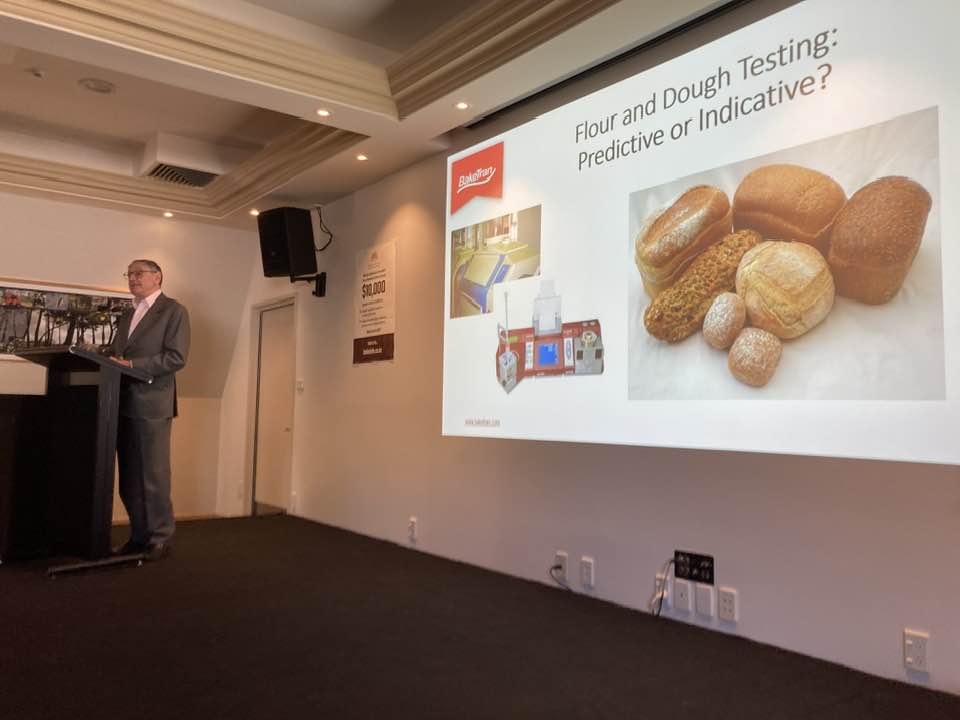Recent Articles
- 2023 Young Bread Baker of the Year Entrants
- Baker’s Fresh Yeast Handling and Use
- Mandatory fortification of bread making flour
- Energy Transfer in CBP/MDD Mixing Equipment – Managing Dough Development
- Value Added Wheat – Genomic Prediction Modelling
- Reduction of Gluten Allergenicity
- Whole grains: the unsung heroes
- Understanding flour specifications
- Bread bags from bread returns
- Machine guarding failures ‘reprehensible’
Presented as part of Technology Transfer Seminars 2023
Stan began his working life in the laboratory of a flour mill as a quality co-ordinator. Being the one who got angry bakers on the phone telling him the flour was no good, his job was to placate them and assure them that the miller had done everything possible to ensure that the flour was within specification and the right quality. He says that in some ways flour testing has not moved on since he joined the industry. Some methods used today go back to the 1920’s, even though we make bread very differently today. He believes there is great opportunity to build on the tradition but to move forward and perhaps reduce the burden on those who work in the flour mills of the future, so they are not on the receiving end of complaints about poor quality and the underperformance of flour.
Stan suggested the key challenge starts with the question of whether flour and dough testing is predictive or indicative. He favours the latter and expressed disappointment in studies that refer to measured flour properties, correlate them with baking performance, and thereby claim a predictive testing method. What those studies fail to do, he says, is specify what the baking method is. Stan gave the example of the evaluation of flour properties and wheat varieties in the UK being based on three hours bulk fermentation for many years, a process which the UK had never used, and which the baking industry had moved way beyond.
The relevance of what is being tested and the reason behind it underpinned Stan’s challenge to bakers to view flour specifications in a new light. He appealed to millers and bakers to be collaborative, pointing out that if bakeries don’t have the right quality flour, they can’t make bread, leaving millers with no purpose either.
He stressed that flour testing and baking are complicated processes for both sides, and in those circumstances, it is necessary to start off with the most appropriate methods, rather than relying on techniques which we have used for centuries – such as stretching a piece of dough in our hands. The Egyptians did it, and we still do it he says, because we feel that we are learning something from doing that.
Stan described the typical analyses a baker is confronted with when a bread flour specification arrives in a bakery, containing terms such as moisture, protein, falling number, damages starch, water absorption, ash/colour and dough rheology. He noted how important it is to know what the standard method is being used and what the measurements actually mean to the baker.
One measurement only he says is fundamental – moisture content. But there is no standard measurement for the rest. So everything else that follows is arbitrary, enshrined in our specifications over generations, and they are not wrong but the information has to be treated differently from the way in which we would normally use numbers.
Which of those numbers tells you what the bread is going to be like? No single number tells a baker all they need to know about flour and the quality of bread it will make. Millers are producing flour for a range of uses. They don’t know what an individual bakery is going to do with it. What is right for one bakery will be no good for another. Stan suggested that bakers may not have been giving millers the right information because they don’t know what the right information is. Is there a solution to this problem?
Examining each item on the list in detail, Stan demonstrated how they are indicative, not predictive, due to the complexity of the measurements which make it difficult to use them meaningfully. The specifications also don’t consider the relation between the numbers, and no-one questions the processes used as the basis for the numbers. He went on to suggest that the real challenge is to get bakers to better understand and interpret the data they have available in the bakery and work with the flour miller to work out how to put that into a flour specification. Tell the miller what you want he urges bakers. Working together, he concludes, is better than trying to understand abstract data. We don’t need to invent new methods. We need to make better use of the information we already have and collate it in a collaborative way so we can move to a better understanding of flour specifications. But there needs to be open mindedness and a slightly different approach.

